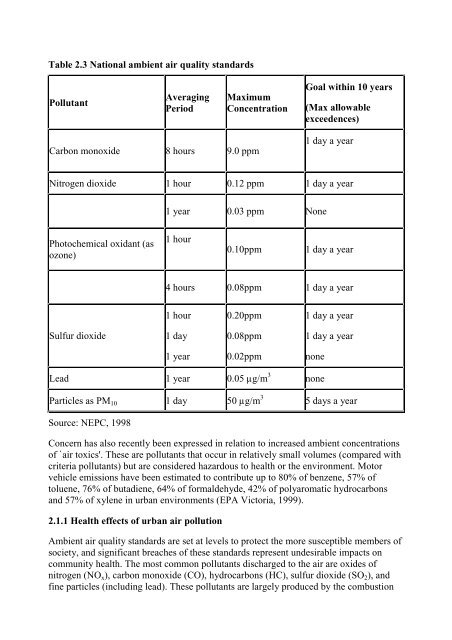National Fuel Quality Standards Regulation Impact Statement 1 ...
National Fuel Quality Standards Regulation Impact Statement 1 ...
National Fuel Quality Standards Regulation Impact Statement 1 ...
You also want an ePaper? Increase the reach of your titles
YUMPU automatically turns print PDFs into web optimized ePapers that Google loves.
Table 2.3 <strong>National</strong> ambient air quality standards<br />
Pollutant<br />
Averaging<br />
Period<br />
Maximum<br />
Concentration<br />
Carbon monoxide 8 hours 9.0 ppm<br />
Goal within 10 years<br />
(Max allowable<br />
exceedences)<br />
1 day a year<br />
Nitrogen dioxide 1 hour 0.12 ppm 1 day a year<br />
Photochemical oxidant (as<br />
ozone)<br />
Sulfur dioxide<br />
1 year 0.03 ppm None<br />
1 hour<br />
0.10ppm 1 day a year<br />
4 hours 0.08ppm 1 day a year<br />
1 hour<br />
1 day<br />
1 year<br />
0.20ppm<br />
0.08ppm<br />
0.02ppm<br />
Lead 1 year 0.05 µg/m 3<br />
Particles as PM10 1 day 50 µg/m 3<br />
Source: NEPC, 1998<br />
1 day a year<br />
1 day a year<br />
none<br />
none<br />
5 days a year<br />
Concern has also recently been expressed in relation to increased ambient concentrations<br />
of `air toxics'. These are pollutants that occur in relatively small volumes (compared with<br />
criteria pollutants) but are considered hazardous to health or the environment. Motor<br />
vehicle emissions have been estimated to contribute up to 80% of benzene, 57% of<br />
toluene, 76% of butadiene, 64% of formaldehyde, 42% of polyaromatic hydrocarbons<br />
and 57% of xylene in urban environments (EPA Victoria, 1999).<br />
2.1.1 Health effects of urban air pollution<br />
Ambient air quality standards are set at levels to protect the more susceptible members of<br />
society, and significant breaches of these standards represent undesirable impacts on<br />
community health. The most common pollutants discharged to the air are oxides of<br />
nitrogen (NOx), carbon monoxide (CO), hydrocarbons (HC), sulfur dioxide (SO2), and<br />
fine particles (including lead). These pollutants are largely produced by the combustion
















